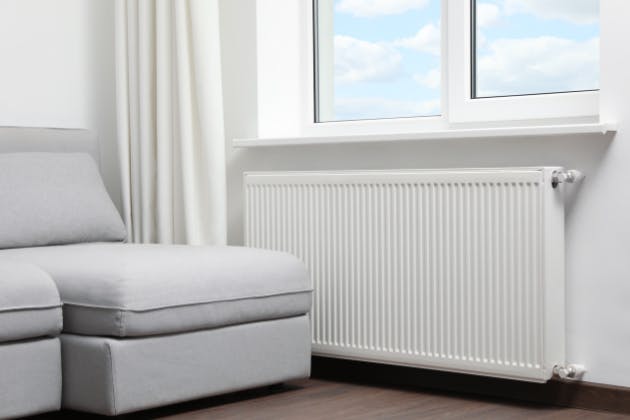If some rooms in your home heat up quickly while others stay cold, it’s a sign your radiators are out of balance. This happens when hot water from your boiler isn’t distributed evenly across the system. Balancing radiators can make a big difference, making sure every room is heated properly while also helping your boiler run more efficiently.
How to Balance Radiators
Tools You’ll Need
- Radiator bleeding key
- Adjustable spanner or lockshield valve adjuster
- Screwdriver
- Digital thermometer (or one built into a multimeter)

Step 1. Switch Off Your Heating
The first step is to turn off your central heating and let the radiators cool down completely. This makes it safe to work on and ensures you get accurate results when you start adjusting valves. It’s also a good idea to bleed your radiators at this point, as trapped air can cause uneven heating that may be mistaken for imbalance.
Step 2. Get Familiar with Your Valves
Take a moment to find and understand the valves on your radiators. The lockshield valve usually sits under a protective cap that may need a screwdriver or spanner to remove. Many modern radiators also have thermostatic radiator valves (TRVs) on the opposite side, which control how much hot water enters the radiator. For balancing, you’ll mainly be adjusting the lockshield valves, while the TRVs should generally stay set at the level you prefer.
Step 3. Open All Valves Fully
Go around your home and open up all the valves by turning them anti-clockwise. TRVs and older wheel-head valves can usually be turned easily by hand. Lockshield valves, however, often need an adjuster or spanner to move them. By opening everything fully, you’re giving your system a fresh start before you begin balancing.
Step 4. See Which Radiators Heat Up First
Turn the heating back on and pay attention to the order in which your radiators warm up. Those closest to the boiler are usually the quickest, while those further away take longer. Jotting this order down will help you stay organised as you move through the process. If you’ve got a larger home with lots of radiators, it can be helpful to have someone else walk around with you.
Step 5. Switch the Heating Off Again
Once you’ve identified the heating order, turn the system off and let everything cool down again. Starting from cold ensures your adjustments will be more accurate. The idea is to control the flow of water so that each radiator warms up evenly, and that’s best done from a completely cooled system. It may feel like a waiting game, but this step makes a real difference to the final result.
Step 6. Adjust the First Radiator
Go back to the radiator that heated up first. Close its lockshield valve completely, then reopen it by about a quarter of a turn. This limits how much hot water it takes, leaving more available for the rest of the system. Small adjustments like this are key to balancing, so take your time and don’t be tempted to open it too far.
Step 7. Take a Temperature Reading
Once the radiator starts to warm up again, measure the temperature at the pipe leading into one of the valves. A digital thermometer or one built into a multimeter works best here. The aim is to see how much heat is entering the radiator before it flows through and exits.
Step 8. Compare Flow and Return Temperatures
Now, take another temperature reading on the opposite pipe as the water leaves the radiator. Ideally, there should be about a 12°C difference between the two readings. If the difference is larger or smaller, adjust the lockshield valve slightly and wait a couple of minutes before rechecking. This ensures the system has time to settle after each adjustment.
Step 9. Work Through the Remaining Radiators
Continue around your home in the order you noted earlier, repeating the same process for each radiator. Generally, the further away the radiator is from the boiler, the more you’ll need to open the lockshield valve. By the time you reach the final radiator, the valve may need to be almost fully open to achieve balance.
Step 10. Enjoy Your Evenly Heated Radiators
Once all your radiators are balanced, you should notice a big improvement in how your home heats up. Rooms that were previously cold should feel warmer, and the temperature across your home will be more consistent. It also means your boiler is working more efficiently, which is good news for energy bills and the lifespan of your system.
Professional Heating Support in Christchurch and New Milton
Balancing radiators can make a big difference, but it can be a time-consuming task if you’re not familiar with heating systems. At A Armstrong Plumbing, we help homeowners in Christchurch and New Milton with everything from radiator balancing to boiler installations, boiler servicing, and general plumbing repairs. Our experienced plumbers can make sure your heating system is running at its best so you can enjoy a comfortable and efficient home. Call us today on 07904590952 or fill out our contact form to book your service.
